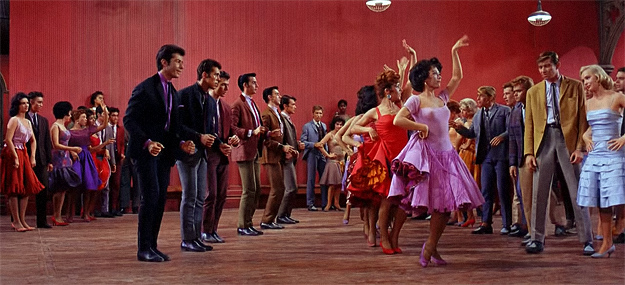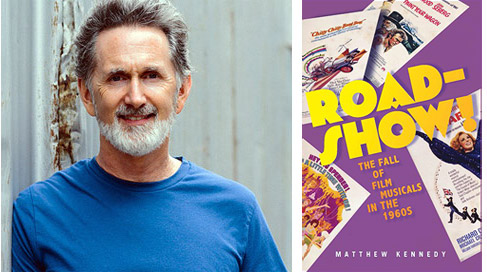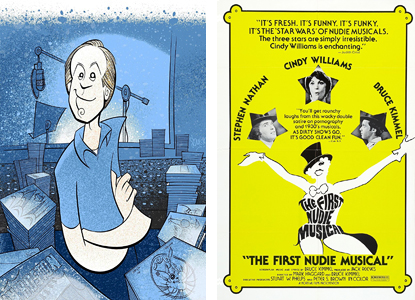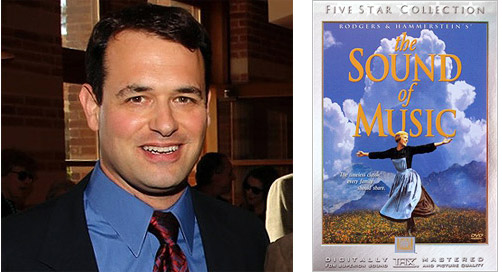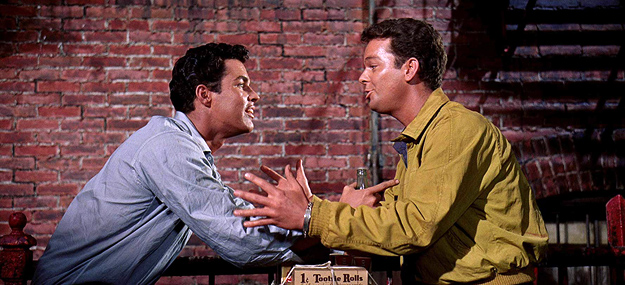
THE ROADSHOW ENGAGEMENTS
What follows, for historical record and nostalgia, is a chronological reference listing of West Side Story’s North American reserved-seat “roadshow” engagements (otherwise known as Phase One of its release cycle). These were special, long-running, showcase presentations in major cities prior to the film being exhibited as a general release. The roadshows featured advanced admission pricing, reserved seating (typically sold in advance), and an average of ten scheduled screenings per week (one per evening, plus a matinee on weekends, Wednesdays and holidays, though this policy varied by locale and/or was modified during the latter phase of engagement).
Most roadshows during this era included an overture, intermission, entr’acte and exit music (or some combination of those components). In the case of West Side Story, the overture included imagery and was played with curtains open, and the intermission and entr’acte were optional. Instead of exit music, Saul Bass’s main credits played at the end. Souvenir roadshow programs were sold as well.
Out of all of the feature films released in North America during 1961, West Side Story was among only six given roadshow treatment by their respective studios. (The other 1961 roadshows were El Cid, Judgment at Nuremberg, King of Kings, La Dolce Vita, and Les Liaisons Dangereuses.)
Roadshow presentations, compared to general release and the average moviegoing experience of the era, typically were booked into the best cinemas and offered a superior overall moviegoing experience. Although West Side Story’s distributor, United Artists, elected not to explicitly promote the film’s presentation tech details, it is understood that many of West Side Story’s roadshow presentations were presented in 70-millimeter and, at a time when most motion pictures were monaural, all of the film’s reserved-seat presentations featured stereophonic sound: 4-track magnetic for 35mm prints and 6-track magnetic for the coveted 70mm prints.
West Side Story’s anniversary offers an opportunity to namedrop some well-known cinemas (most of which no longer exist), to provide some nostalgia for those readers who saw the film during this phase of its original release, and to reflect on how motion picture production and exhibition trends have evolved over the decades.
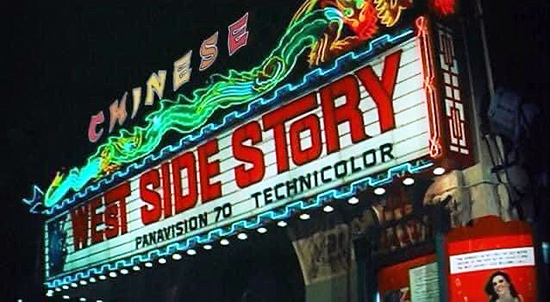
Premiere Date … Locale — Cinema (duration in weeks)
- 1961-10-18 … New York – Rivoli (77)
- 1961-11-01 … Boston – Gary (49)
- 1961-11-07 … Philadelphia – Midtown (52)
- 1961-11-14 … Washington – Uptown (42)
- 1961-12-13 … Los Angeles – Chinese (58)
- 1961-12-14 … Miami (Miami Beach) – Sheridan (52)
- 1961-12-14 … San Francisco – United Artists (46)
- 1962-01-18 … Honolulu – Kuhio (8)
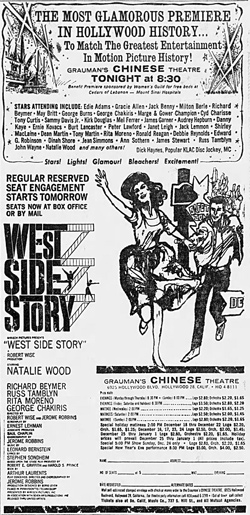 1962-02-22 … Montreal – Alouette (31)
1962-02-22 … Montreal – Alouette (31)- 1962-02-21 … Seattle – Music Box (40)
- 1962-02-20 … Chicago – Michael Todd (38)
- 1962-02-16 … Minneapolis – Mann (28)
- 1962-02-15 … Dallas – Esquire (20)
- 1962-02-14 … San Diego – Capri (36)
- 1962-02-14 … Detroit – Madison (36)
- 1962-02-14 … Cleveland – Ohio (19)
- 1962-02-14 … Baltimore – Mayfair (17)
- 1962-02-08 … Pittsburgh – Nixon (32)
- 1962-03-01 … St. Louis – Mid-City (17)
- 1962-03-14 … Milwaukee – Strand (31)
- 1962-03-14 … Portland – Music Box (36)
- 1962-03-15 … Buffalo – Teck (15)
- 1962-03-21 … Kansas City – Plaza (13)
- 1962-03-21 … Salt Lake City – South East (39)
- 1962-03-21 … Vancouver – Stanley (29)
- 1962-03-22 … Cincinnati – Valley (25)
- 1962-03-28 … Phoenix (Scottsdale) – Kachina (15)
- 1962-03-29 … Atlanta – Rhodes (23)
- 1962-04-04 … Albany – Hellman (10)
- 1962-04-04 … Houston – Tower (15)
- 1962-04-04 … New Orleans – Civic (10)
- 1962-04-04 … Tampa – Florida (11)
- 1962-04-05 … Rochester – Riviera (26)
- 1962-04-05 … Syracuse (DeWitt) – Shoppingtown (16)
- 1962-04-10 … Hartford – Strand (21)
- 1962-04-11 … Des Moines – Capri (16)
- 1962-04-11 … New Haven – Whalley (26)
- 1962-04-11 … Omaha – Admiral (15)
- 1962-04-11 … Providence – Elmwood (15)
- 1962-04-11 … Toledo – Esquire (10)
- 1962-04-13 … Asbury Park – St. James (24)
- 1962-04-13 … Newark (Upper Montclair) – Bellevue (36)
- 1962-04-13 … Long Island (Syosset) – Syosset (38)
- 1962-04-13 … Youngstown – State (10)
- 1962-04-18 … Richmond – Willow Lawn (13)
- 1962-04-19 … Oklahoma City – State (13)
- 1962-05-02 … Denver – Denham (28)
- 1962-05-02 … Tucson – Catalina (10)
- 1962-05-17 … Toronto – Tivoli (31)
- 1962-06-21 … Columbus – Cinestage (25)
- 1962-06-27 … Indianapolis – Lyric (11)
- 1962-06-27 … Louisville – Brown (14)
- 1962-06-27 … Winnipeg – Garrick (6)
- 1962-06-28 … Dayton – McCook (23)
- 1962-06-28 … New City/Rockland Co. (Nanuet) – Route 59 (19)
On December 5th, 1961, in connection with the release of West Side Story, Natalie Wood immortalized her hand and foot prints in the courtyard of the Chinese Theater in Los Angeles.
It should be noted the engagements cited above represent only a fraction of the thousands of total bookings throughout the many cycles of distribution over the course of West Side Story’s release. As such, this work does not include any of the film’s reserved performance (i.e. modified roadshow), general release, second-run, re-release, etc.
A roadshow policy was implemented as well on West Side Story’s initial release in key overseas markets. Researching and citing all of them is beyond the scope of this work, though some noteworthy examples worth mentioning include lengthy, successful runs in Paris (George V, 218 weeks), London (Astoria, 94 weeks), Sydney (Mayfair, 67 weeks), and Tokyo (Piccadilly, 66 weeks).
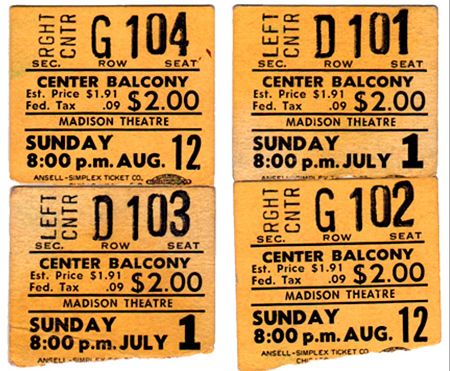
THE Q&A
Matthew Kennedy is the author of Roadshow! The Fall of Film Musicals in the 1960s (Oxford University Press, 2014). His other books include Joan Blondell: A Life Between Takes (University of Mississippi Press, 2007), Edmund Goulding’s Dark Victory: Hollywood’s Genius Bad Boy (University of Wisconsin Press, 2004), and Marie Dressler: A Biography (McFarland, 1999). He is the curator and host of the CinemaLit Film Series at Mechanics’ Institute San Francisco.
Bruce Kimmel is the screenwriter/composer/lyricist/co-star/co-director of The First Nudie Musical (1976). He is also the president of Kritzerland, a record label specializing in limited edition soundtracks and Broadway show albums.
Mike Matessino worked for Robert Wise Productions from 1994 through 2004 during which time he produced and directed The Sound of Music: From Fact to Phenomenon and served as Post-Production Supervisor on Star Trek: The Motion Picture—The Director’s Edition. He also produced soundtrack albums for Star Trek, The Sand Pebbles and The Day the Earth Stood Still.
The interviews were conducted separately and edited into a “roundtable” conversation format.
Michael Coate (The Digital Bits): How do you think West Side Story ought to be remembered on its 60th anniversary?
Bruce Kimmel: As a groundbreaking movie, brilliantly done, and still one of the greatest movie musicals ever made.
Mike Matessino: It should be simply recognized as the classic that it is, and we couldn’t ask for a better way to do that than to have the release of Steven Spielberg’s new version, even though that was originally supposed to debut last year. Any time any movie has a remake or a sequel, people learn about and see the original. Especially for young viewers, any time you can get people to watch and appreciate a 60-year-old film, it’s a good thing for the preservation of movie history. It’s also a big anniversary year for Robert Wise films… the 80th of Citizen Kane (which he edited), the 70th of The Day the Earth Stood Still, and the 50th of The Andromeda Strain, which has an added resonance when you look at it in light of the Covid pandemic.
Matthew Kennedy: West Side Story should be remembered as a great example of the Event Musical. Director Jerome Robbins updated Romeo and Juliet and set it among rival gangs in a tough New York neighborhood, with the ensuing drama largely sung and danced. How absolutely brilliant is that idea? Engage genius collaborators, composer Leonard Bernstein, playwright Arthur Laurents, and lyricist Stephen Sondheim, and creative sparks will fly. United Artists reengaged Robbins for the film’s choreography, promoting him to co-director with Robert Wise. That was a smart move, ensuring West Side Story would become pound-for-pound the greatest dance movie of them all. If that’s hyperbolic, I’m hard pressed to put forth any serious competitors. Prologue, Dance at the Gym, America, Cool… I rest my case.
The Digital Bits: What was your first impression of the film?
Kimmel: I saw the film during its opening week at the Chinese Theater, maybe even on its second or third day, at a matinee (only one matinee and one evening show a day). I was bowled over by it in every way—the story, the dancing, the songs, the performance, the clarity of the 70mm image, the sound—I went back the next day and saw it again and then once a week for the next fourteen weeks. Maybe I was a little obsessed with it.
Matessino: I did not have any special first viewing of this film. It was a commercial TV airing sometime long after I’d first seen The Sound of Music. So while I love the score for West Side Story, I had no great initial impression of the film as it seemed rather stagey by comparison. In 1980 I saw the Broadway revival and loved it, so I carried that impression into my first viewing of the movie in 35mm about 10 years later. It was only a few years after that when I started working with Robert Wise, and I was with him for the first video transfer that was done from 65mm for LaserDisc (and then again later for DVD). That’s when I started to really appreciate the quality of the film, particularly in the genius of the compositions and the editing. I still prefer the stage show, and Bob knew that, and that feeling hasn’t changed.
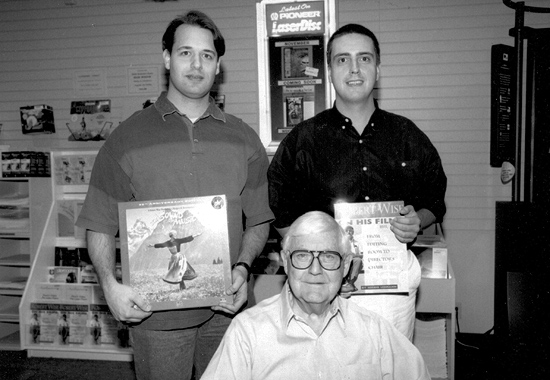
Kennedy: I don’t have a clear memory of the first time I saw West Side Story. It was probably on one of its commercial TV airings at prime time, way back long before VCRs or DVDs or Turner or streaming.
Kimmel: I know it’s become fashionable to call the film out for various things, which I find incredibly irritating—“It’s dated”… “Richard Beymer sucks”… “Natalie Wood is white”… “they’re all so old, playing young people”… and on and on. Well, it wasn’t made today, folks, so, oh, well. My opinion of the film has never changed—I loved it then, I love it now. It’s not dated because it doesn’t take place now. Funny how that works. I know lots don’t like Beymer but I liked him just fine and already knew him from The Diary of Anne Frank and High Time. Natalie Wood is at her best as Maria and that’s considerable. As to they’re all so old, I did a comparison of the ages of the original film and the remake—where critics are idiotically saying “How great to have actual young people.” Well, Natalie Wood was twenty-two as opposed to Rachel Zegler is twenty. Richard Beymer was also twenty-two as opposed to Ansel Elgort’s being twenty-seven. Oops. I believe the Anita and Bernardo are the exact same ages as Rita Moreno and George Chakiris were. And I’m pretty sure that most of the Jets and Sharks were younger in the original.
The Digital Bits: In what way is West Side Story a significant motion picture?
Kennedy: It’s a bit surprising today, considering West Side Story’s lofty reputation, but the stage version was not a massive hit. My Fair Lady and The Music Man were on Broadway alongside West Side Story, and both ran much longer. Despite some missteps in adapting it to the screen, it was a bigger hit on film than on stage. It won ten Oscars, more than any musical before or since. So the film stands as a prime example of successfully rendering a stage musical in cinematic terms.
Kimmel: Like the stage version, it pushed where the film musical could go, it was very relevant to its time period, and it had everything you’d ever want in a movie.
Matessino: The film version of South Pacific was a huge hit in 1958 and played for several years, but after that, there was sort of a slump when it came to Broadway musical film adaptations to the point that the prevailing feeling was that audiences were losing interest in them. So one of the most significant things about West Side Story is that it proved this was not the case. Of course, the show on which was based was a game-changer in musical theatre, but when the film version went on to become the top hit of the year and win multiple Oscars, producers and studios had more confidence about the genre. Once My Fair Lady and The Sound of Music came a few years later, it was clear that musicals could be huge moneymakers. What happened after that is a different story, of course, but West Side Story definitely lit that spark.
